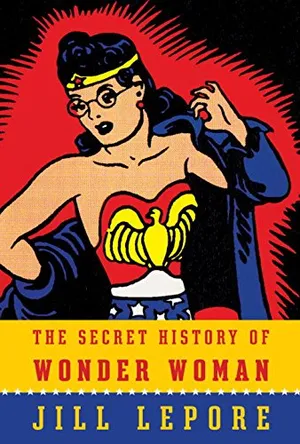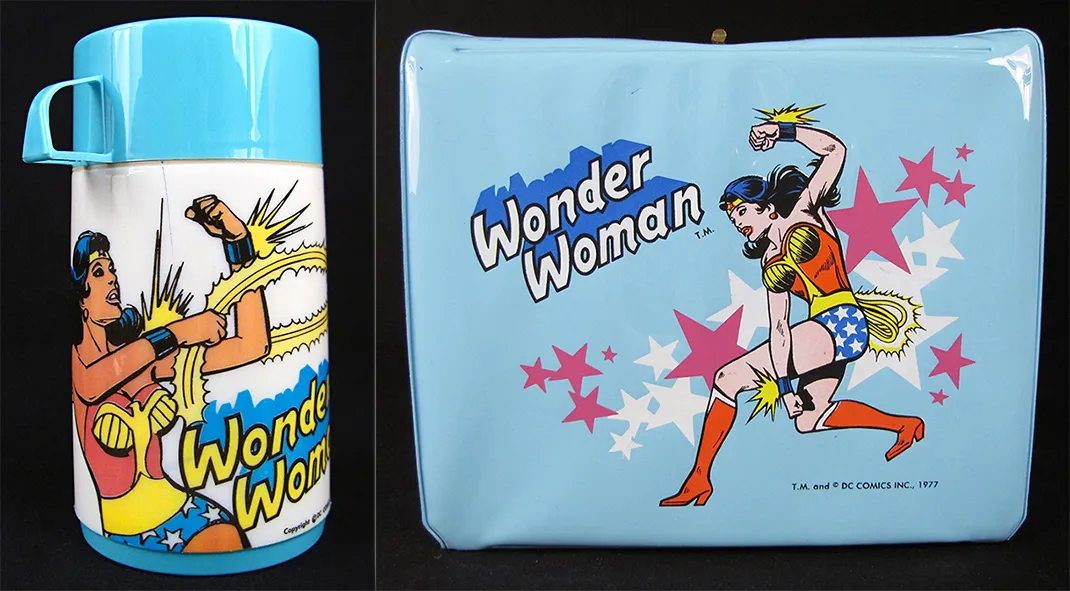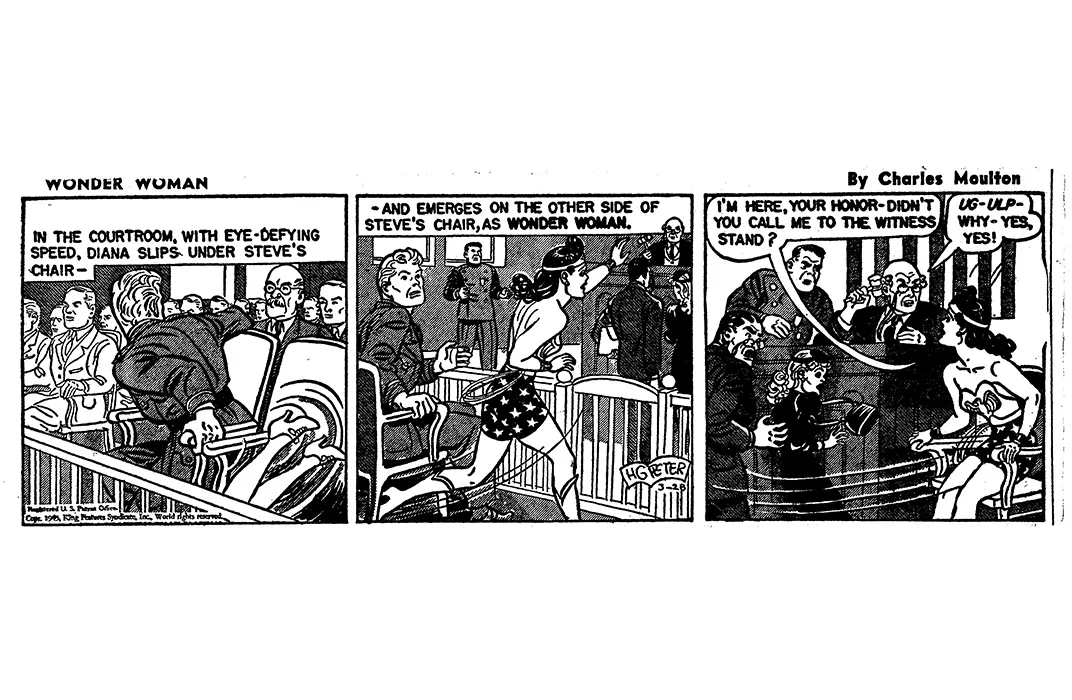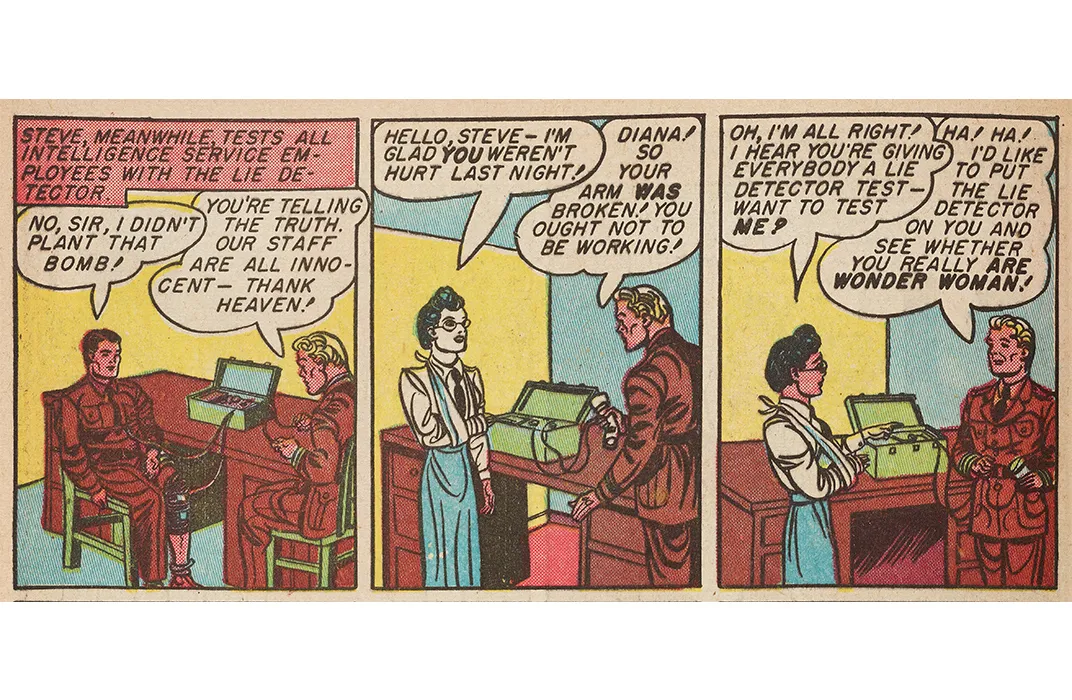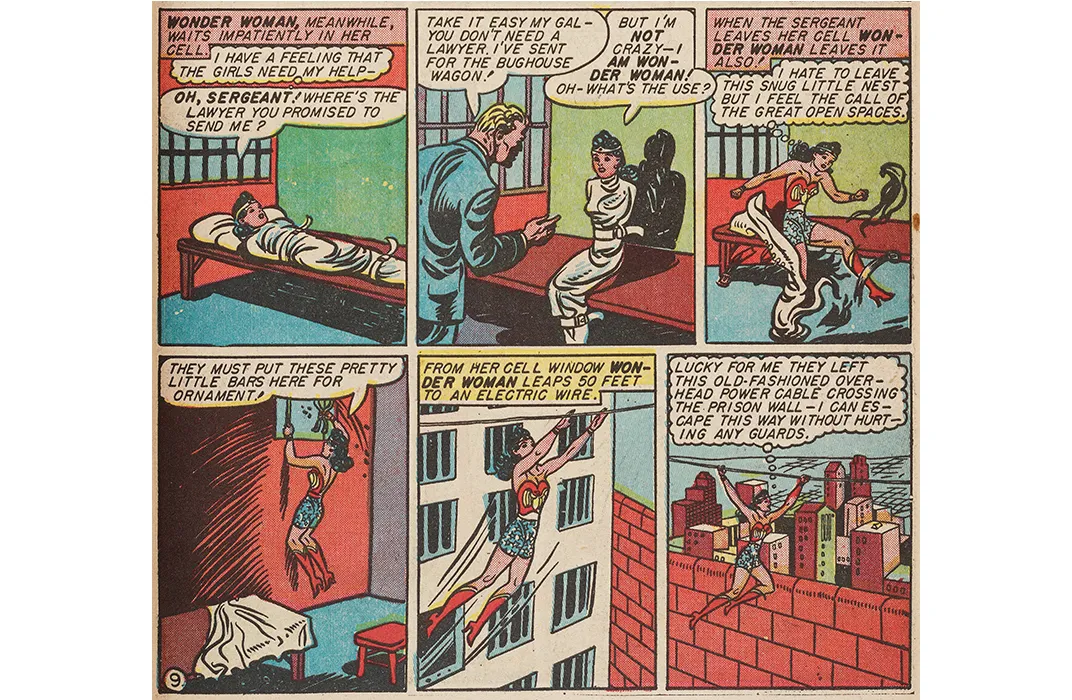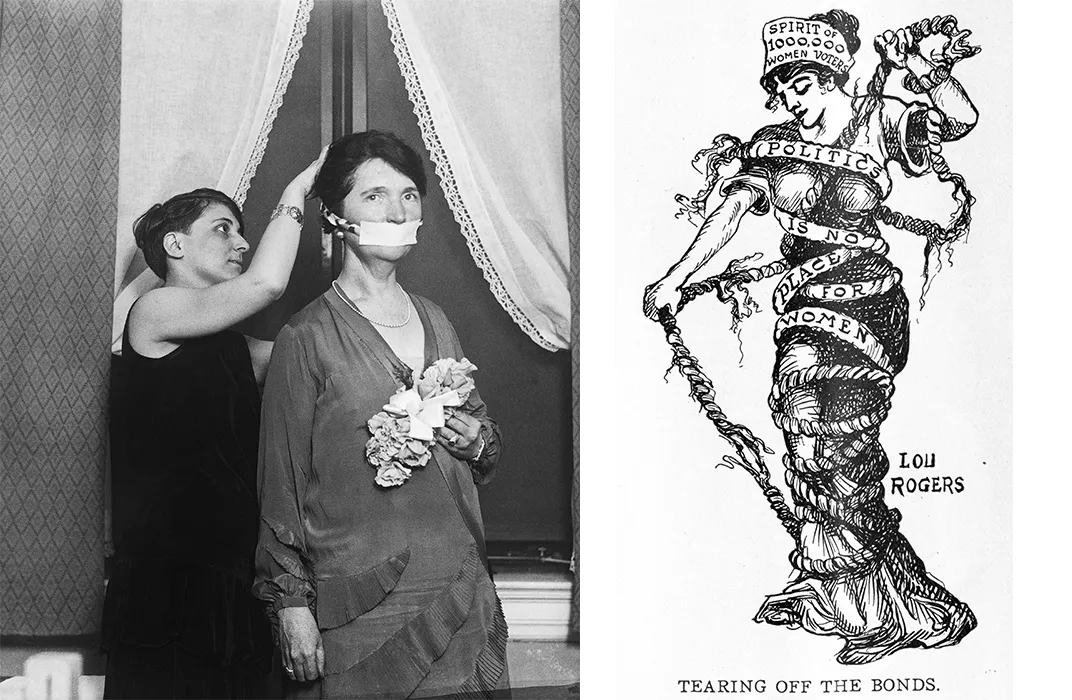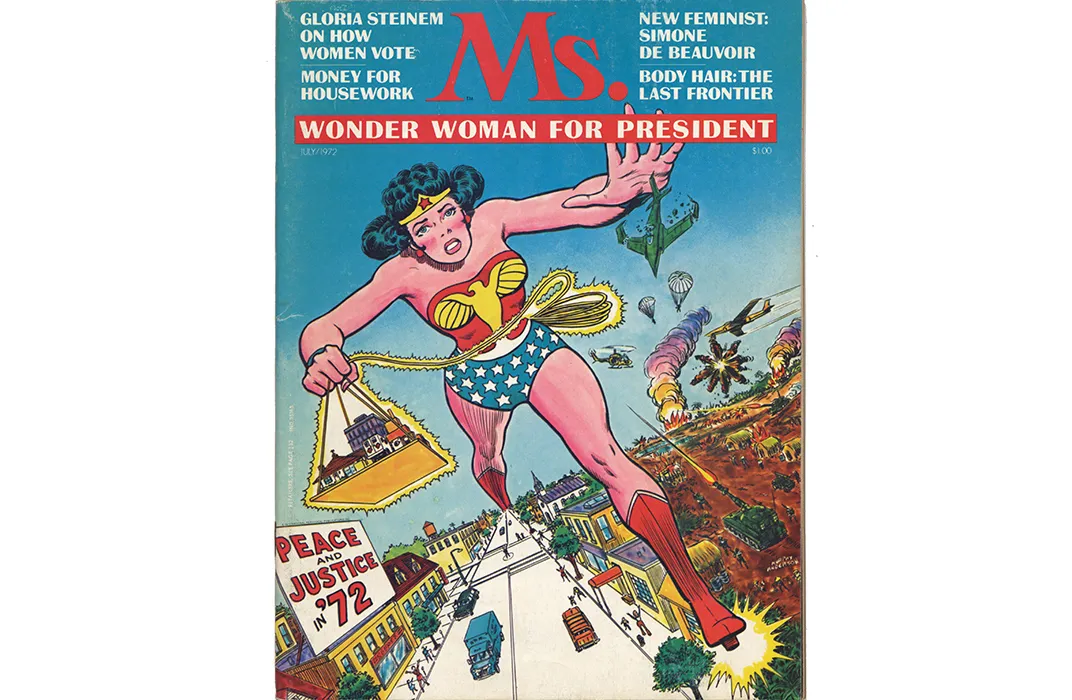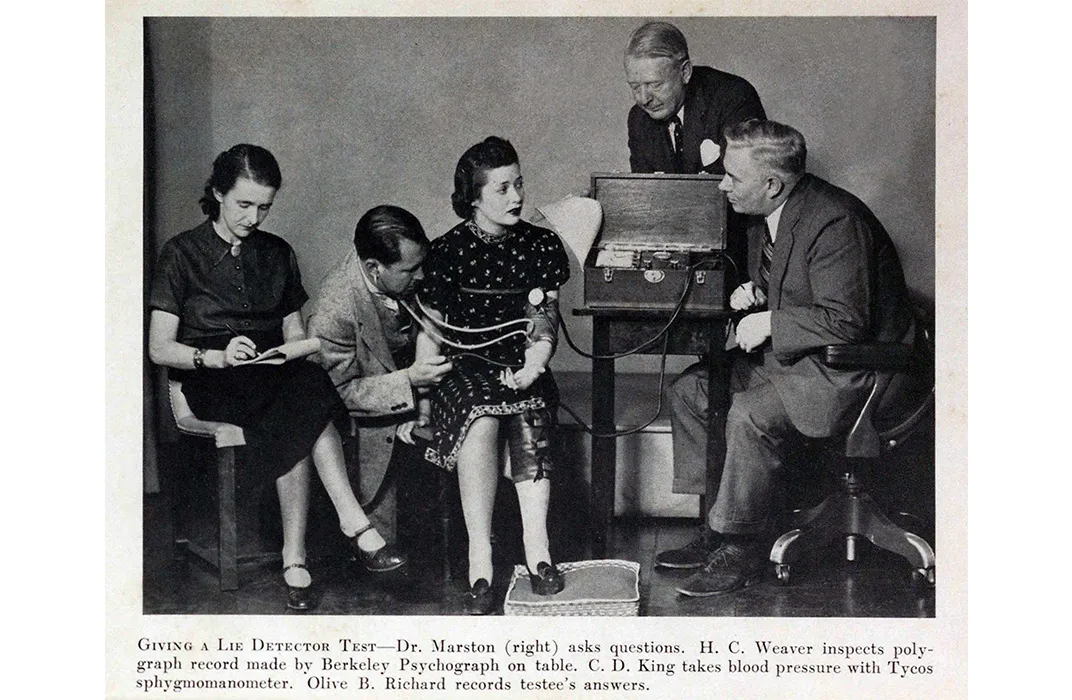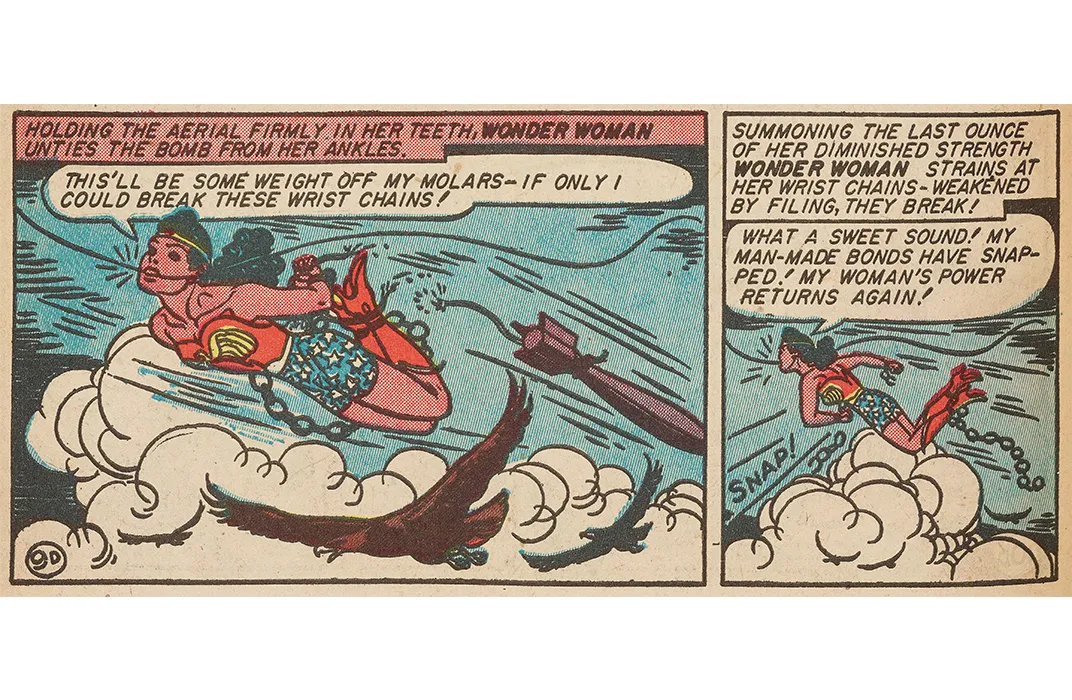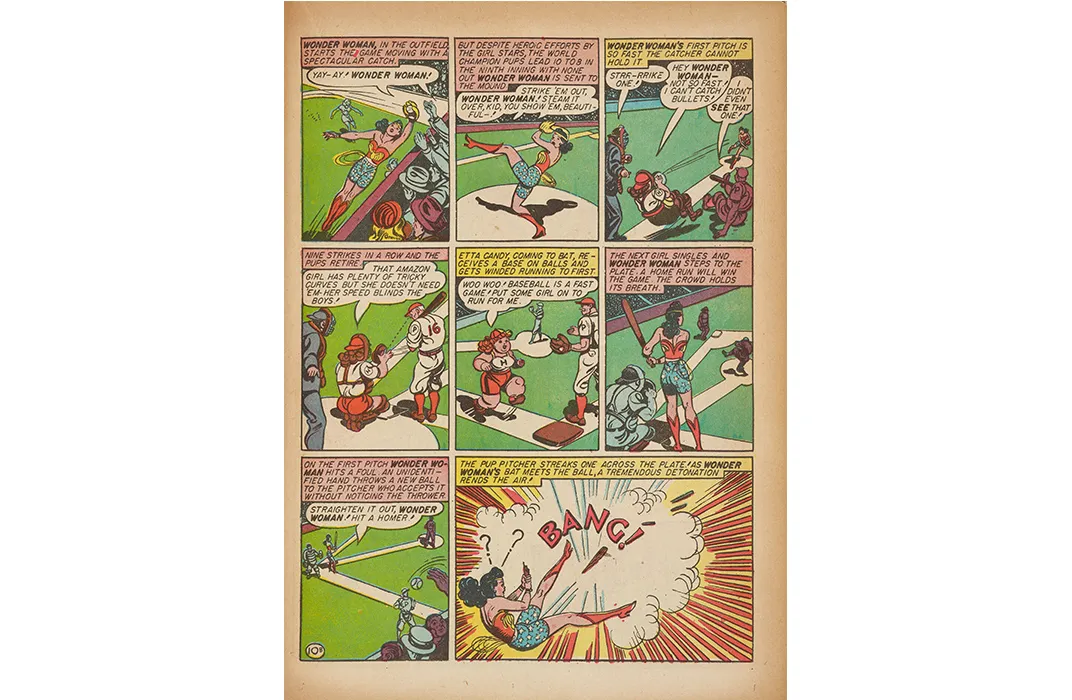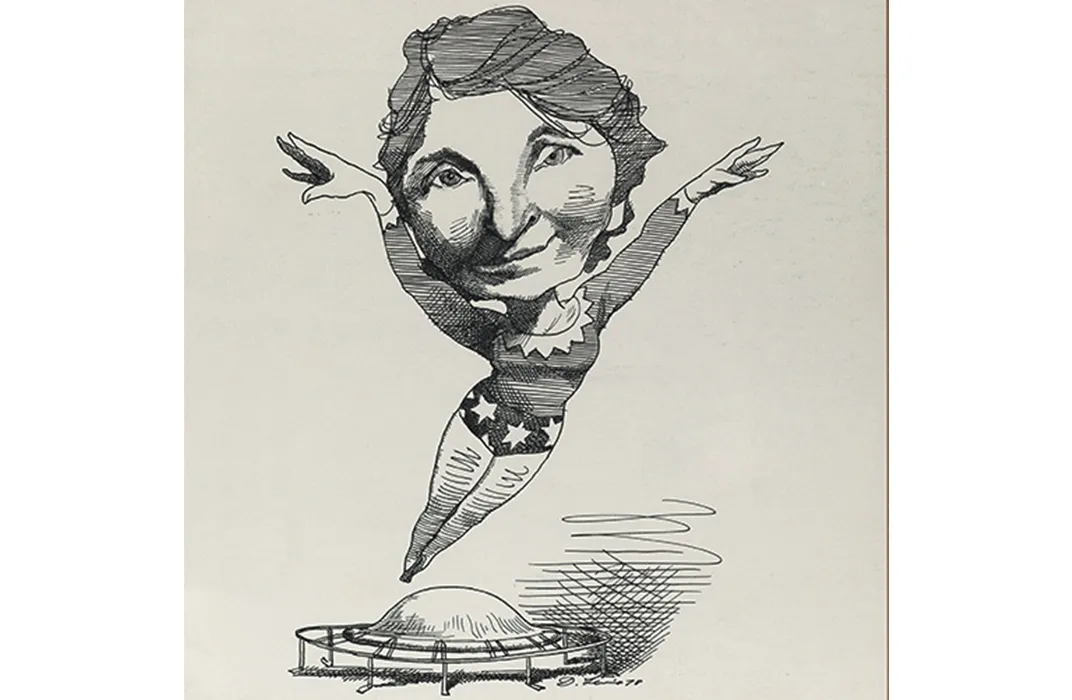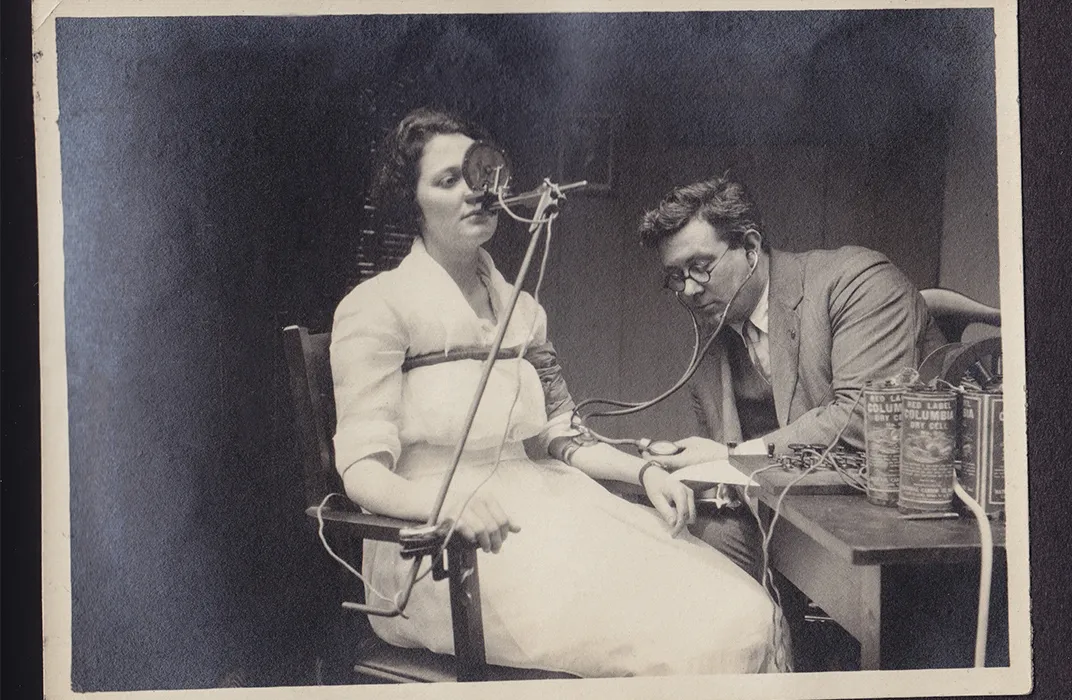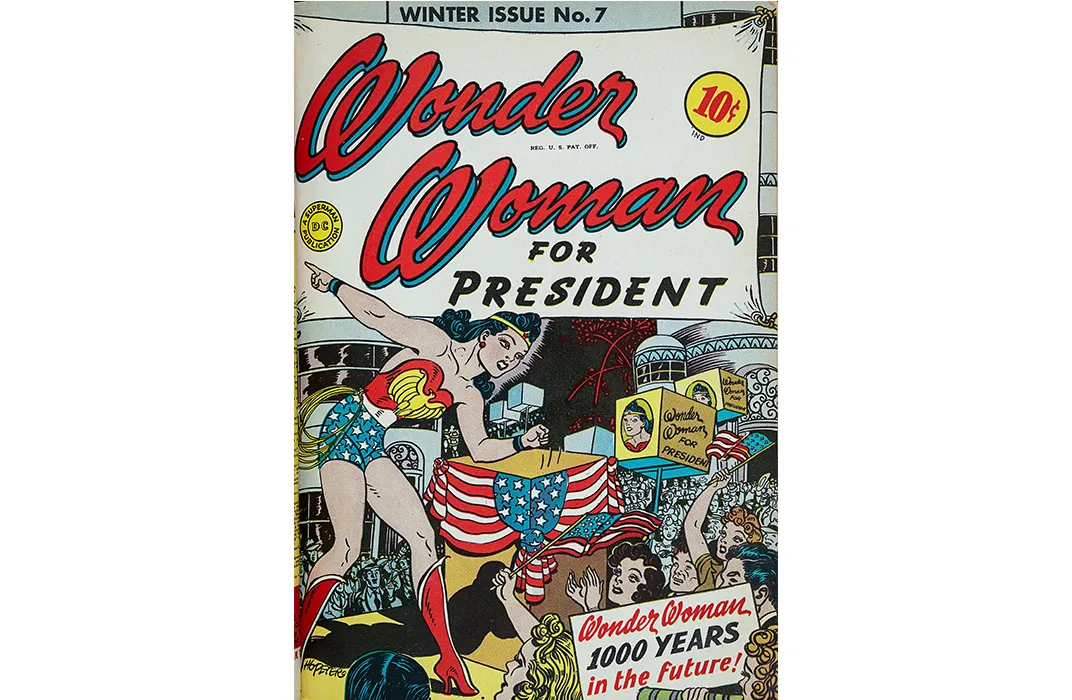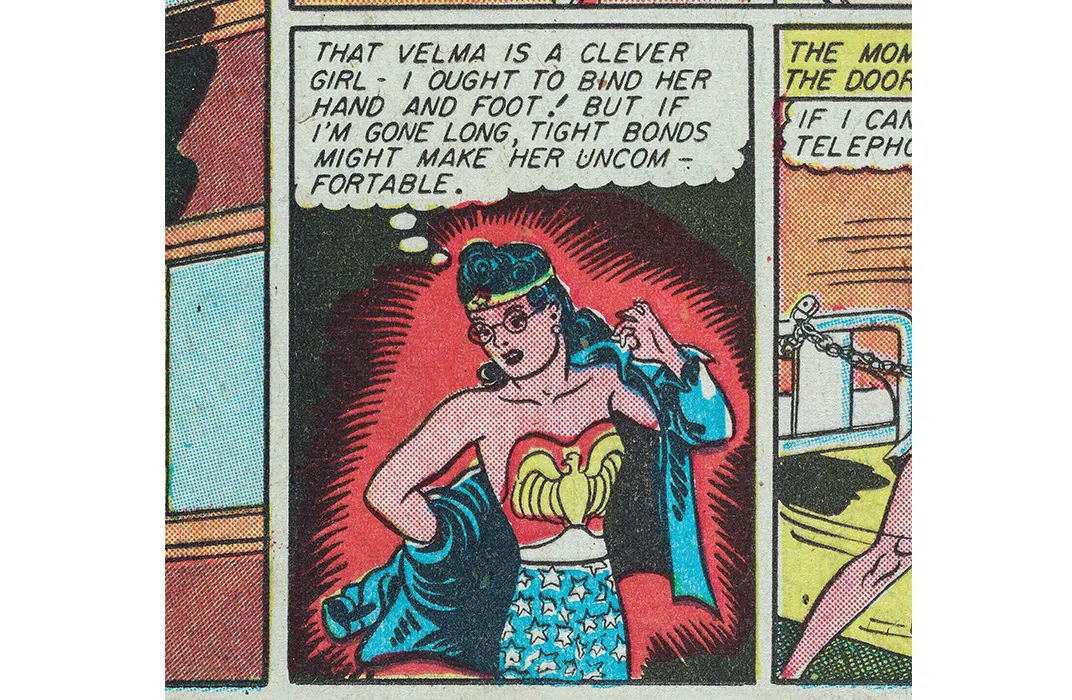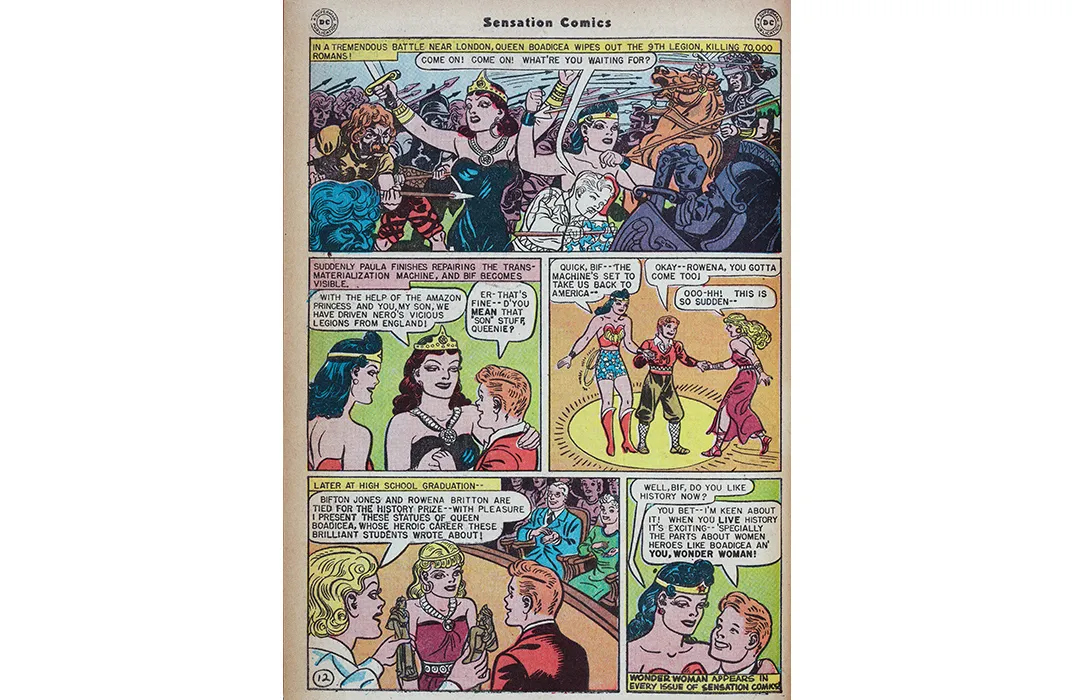The Surprising Origin Story of Wonder Woman
The history of the comic-book superhero’s creation seven decades ago has been hidden away—until now
/https://tf-cmsv2-smithsonianmag-media.s3.amazonaws.com/filer/5c/52/5c52beda-b4ef-4756-9e6f-77e0c7b8518f/oct14_g12_wonderwoman-1.jpg)
“Noted Psychologist Revealed as Author of Best-Selling ‘Wonder Woman,’” read the astonishing headline. In the summer of 1942, a press release from the New York offices of All-American Comics turned up at newspapers, magazines and radio stations all over the United States. The identity of Wonder Woman’s creator had been “at first kept secret,” it said, but the time had come to make a shocking announcement: “the author of ‘Wonder Woman’ is Dr. William Moulton Marston, internationally famous psychologist.” The truth about Wonder Woman had come out at last.
Or so, at least, it was made to appear. But, really, the name of Wonder Woman’s creator was the least of her secrets.
Wonder Woman is the most popular female comic-book superhero of all time. Aside from Superman and Batman, no other comic-book character has lasted as long. Generations of girls have carried their sandwiches to school in Wonder Woman lunchboxes. Like every other superhero, Wonder Woman has a secret identity. Unlike every other superhero, she also has a secret history.
In one episode, a newspaper editor named Brown, desperate to discover Wonder Woman’s past, assigns a team of reporters to chase her down; she easily escapes them. Brown, gone half mad, is committed to a hospital. Wonder Woman disguises herself as a nurse and brings him a scroll. “This parchment seems to be the history of that girl you call ‘Wonder Woman’!” she tells him. “A strange, veiled woman left it with me.” Brown leaps out of bed and races back to the city desk, where he cries out, parchment in hand, “Stop the presses! I’ve got the history of Wonder Woman!” But Wonder Woman’s secret history isn’t written on parchment. Instead, it lies buried in boxes and cabinets and drawers, in thousands of documents, housed in libraries, archives and collections spread all over the United States, including the private papers of creator Marston—papers that, before I saw them, had never before been seen by anyone outside of Marston’s family.
The veil that has shrouded Wonder Woman’s past for seven decades hides beneath it a crucial story about comic books and superheroes and censorship and feminism. As Marston once put it, “Frankly, Wonder Woman is psychological propaganda for the new type of woman who, I believe, should rule the world.”
Comic books were more or less invented in 1933 by Maxwell Charles Gaines, a former elementary school principal who went on to found All-American Comics. Superman first bounded over tall buildings in 1938. Batman began lurking in the shadows in 1939. Kids read them by the piles. But at a time when war was ravaging Europe, comic books celebrated violence, even sexual violence. In 1940, the Chicago Daily News called comics a “national disgrace.” “Ten million copies of these sex-horror serials are sold every month,” wrote the newspaper’s literary editor, calling for parents and teachers to ban the comics, “unless we want a coming generation even more ferocious than the present one.”
To defend himself against critics, Gaines, in 1940, hired Marston as a consultant. “‘Doc’ Marston has long been an advocate of the right type of comic magazines,” he explained. Marston held three degrees from Harvard, including a PhD in psychology. He led what he called “an experimental life.” He’d been a lawyer, a scientist and a professor. He is generally credited with inventing the lie detector test: He was obsessed with uncovering other people’s secrets. He’d been a consulting psychologist for Universal Pictures. He’d written screenplays, a novel and dozens of magazine articles. Gaines had read about Marston in an article in Family Circle magazine. In the summer of 1940, Olive Richard, a staff writer for the magazine, visited Marston at his house in Rye, New York, to ask him for his expert opinion about comics.
“Some of them are full of torture, kidnapping, sadism, and other cruel business,” she said.
“Unfortunately, that is true,” Marston admitted, but “when a lovely heroine is bound to the stake, comics followers are sure that the rescue will arrive in the nick of time. The reader’s wish is to save the girl, not to see her suffer.”
Marston was a man of a thousand lives and a thousand lies. “Olive Richard” was the pen name of Olive Byrne, and she hadn’t gone to visit Marston—she lived with him. She was also the niece of Margaret Sanger, one of the most important feminists of the 20th century. In 1916, Sanger and her sister, Ethel Byrne, Olive Byrne’s mother, had opened the first birth-control clinic in the United States. They were both arrested for the illegal distribution of contraception. In jail in 1917, Ethel Byrne went on a hunger strike and nearly died.
Olive Byrne met Marston in 1925, when she was a senior at Tufts; he was her psychology professor. Marston was already married, to a lawyer named Elizabeth Holloway. When Marston and Byrne fell in love, he gave Holloway a choice: either Byrne could live with them, or he would leave her. Byrne moved in. Between 1928 and 1933, each woman bore two children; they lived together as a family. Holloway went to work; Byrne stayed home and raised the children. They told census-takers and anyone else who asked that Byrne was Marston’s widowed sister-in-law. “Tolerant people are the happiest,” Marston wrote in a magazine essay in 1939, so “why not get rid of costly prejudices that hold you back?” He listed the “Six Most Common Types of Prejudice.” Eliminating prejudice number six—“Prejudice against unconventional people and non-conformists”—meant the most to him. Byrne’s sons didn’t find out that Marston was their father until 1963—when Holloway finally admitted it—and only after she extracted a promise that no one would raise the subject ever again.
Gaines didn’t know any of this when he met Marston in 1940 or else he would never have hired him: He was looking to avoid controversy, not to court it. Marston and Wonder Woman were pivotal to the creation of what became DC Comics. (DC was short for Detective Comics, the comic book in which Batman debuted.) In 1940, Gaines decided to counter his critics by forming an editorial advisory board and appointing Marston to serve on it, and DC decided to stamp comic books in which Superman and Batman appeared with a logo, an assurance of quality, reading, “A DC Publication.” And, since “the comics’ worst offense was their blood-curdling masculinity,” Marston said, the best way to fend off critics would be to create a female superhero.
“Well, Doc,” Gaines said, “I picked Superman after every syndicate in America turned it down. I’ll take a chance on your Wonder Woman! But you’ll have to write the strip yourself.”
In February 1941, Marston submitted a draft of his first script, explaining the “under-meaning” of Wonder Woman’s Amazonian origins in ancient Greece, where men had kept women in chains, until they broke free and escaped. “The NEW WOMEN thus freed and strengthened by supporting themselves (on Paradise Island) developed enormous physical and mental power.” His comic, he said, was meant to chronicle “a great movement now under way—the growth in the power of women.”
Wonder Woman made her debut in All-Star Comics at the end of 1941 and on the cover of a new comic book, Sensation Comics, at the beginning of 1942, drawn by an artist named Harry G. Peter. She wore a golden tiara, a red bustier, blue underpants and knee-high, red leather boots. She was a little slinky; she was very kinky. She’d left Paradise to fight fascism with feminism, in “America, the last citadel of democracy, and of equal rights for women!”
It seemed to Gaines like so much good, clean, superpatriotic fun. But in March 1942, the National Organization for Decent Literature put Sensation Comics on its blacklist of “Publications Disapproved for Youth” for one reason: “Wonder Woman is not sufficiently dressed.”
Gaines decided he needed another expert. He turned to Lauretta Bender, an associate professor of psychiatry at New York University’s medical school and a senior psychiatrist at Bellevue Hospital, where she was director of the children’s ward, an expert on aggression. She’d long been interested in comics but her interest had grown in 1940, after her husband, Paul Schilder, was killed by a car while walking home from visiting Bender and their 8-day-old daughter in the hospital. Bender, left with three children under the age of 3, soon became painfully interested in studying how children cope with trauma. In 1940, she conducted a study with Reginald Lourie, a medical resident under her supervision, investigating the effect of comics on four children brought to Bellevue Hospital for behavioral problems. Tessie, 12, had witnessed her father, a convicted murderer, kill himself. She insisted on calling herself Shiera, after a comic-book girl who is always rescued at the last minute by the Flash. Kenneth, 11, had been raped. He was frantic unless medicated or “wearing a Superman cape.” He felt safe in it—he could fly away if he wanted to—and “he felt that the cape protected him from an assault.” Bender and Lourie concluded the comic books were “the folklore of this age,” and worked, culturally, the same way fables and fairy tales did.
That hardly ended the controversy. In February 1943, Josette Frank, an expert on children’s literature, a leader of the Child Study Association and a member of Gaines’ advisory board, sent Gaines a letter, telling him that while she’d never been a fan of Wonder Woman, she felt she now had to speak out about its “sadistic bits showing women chained, tortured, etc.” She had a point. In episode after episode, Wonder Woman is chained, bound, gagged, lassoed, tied, fettered and manacled. “Great girdle of Aphrodite!” she cries at one point. “Am I tired of being tied up!”
The story behind the writing and editing of Wonder Woman can be pieced together from Bender’s papers, at Brooklyn College; Frank’s papers, at the University of Minnesota; and Marston’s editorial correspondence, along with a set of original scripts, housed at the Dibner Library at the Smithsonian Institution Libraries. In his original scripts, Marston described scenes of bondage in careful, intimate detail with utmost precision. For a story about Mars, the God of War, Marston gave Peter elaborate instructions for the panel in which Wonder Woman is taken prisoner:
“Closeup, full length figure of WW. Do some careful chaining here—Mars’s men are experts! Put a metal collar on WW with a chain running off from the panel, as though she were chained in the line of prisoners. Have her hands clasped together at her breast with double bands on her wrists, her Amazon bracelets and another set. Between these runs a short chain, about the length of a handcuff chain—this is what compels her to clasp her hands together. Then put another, heavier, larger chain between her wrist bands which hangs in a long loop to just above her knees. At her ankles show a pair of arms and hands, coming from out of the panel, clasping about her ankles. This whole panel will lose its point and spoil the story unless these chains are drawn exactly as described here.”
Later in the story, Wonder Woman is locked in a cell. Straining to overhear a conversation in the next room, through the amplification of “bone conduction,” she takes her chain in her teeth: “Closeup of WW’s head shoulders. She holds her neck chain between her teeth. The chain runs taut between her teeth and the wall, where it is locked to a steel ring bolt.”
Gaines forwarded Frank’s letter of complaint to Marston. Marston shrugged it off. But then Dorothy Roubicek, who helped edit Wonder Woman—the first woman editor at DC Comics—objected to Wonder Woman’s torture, too.
“Of course I wouldn’t expect Miss Roubicek to understand all this,” Marston wrote Gaines. “After all I have devoted my entire life to working out psychological principles. Miss R. has been in comics only 6 months or so, hasn’t she? And never in psychology.” But “the secret of woman’s allure,” he told Gaines, is that “women enjoy submission—being bound.”
Gaines was troubled. Roubicek, who worked on Superman, too, had invented kryptonite. She believed superheroes ought to have vulnerabilities. She told Gaines she thought Wonder Woman ought to be more like Superman and, just as Superman couldn’t go back to the planet Krypton, Wonder Woman ought not to be able to go back to Paradise Island, where the kinkiest stuff tended to happen. Gaines then sent Roubicek to Bellevue Hospital to interview Bender. In a memo to Gaines, Roubicek reported that Bender “does not believe that Wonder Woman tends to masochism or sadism.” She also liked the way Marston was playing with feminism, Roubicek reported: “She believes that Dr. Marston is handling very cleverly this whole ‘experiment’ as she calls it. She feels that perhaps he is bringing to the public the real issue at stake in the world (and one which she feels may possibly be a direct cause of the present conflict) and that is that the difference between the sexes is not a sex problem, nor a struggle for superiority, but rather a problem of the relation of one sex to the other.” Roubicek summed up: “Dr. Bender believes that this strip should be left alone.”
Gaines was hugely relieved, at least until September 1943, when a letter arrived from John D. Jacobs, a U.S. Army staff sergeant in the 291st Infantry, stationed at Fort Leonard Wood, Missouri. “I am one of those odd, perhaps unfortunate men who derive an extreme erotic pleasure from the mere thought of a beautiful girl, chained or bound, or masked, or wearing extreme high-heels or high-laced boots,—in fact, any sort of constriction or strain whatsoever,” Jacobs wrote. He wanted to know whether the author of Wonder Woman himself had in his possession any of the items depicted in the stories, “the leather mask, or the wide iron collar from Tibet, or the Greek ankle manacle? Or do you just ‘dream up’ these things?”
(For the record, Marston and Olive Byrne’s son, Byrne Marston, who is an 83-year-old retired obstetrician, thinks that when Marston talked about the importance of submission, he meant it only metaphorically. “I never saw anything like that in our house,” he told me. “He didn’t tie the ladies up to the bedpost. He’d never have gotten away with it.”)
Gaines forwarded Jacobs’ letter to Marston, with a note: “This is one of the things I’ve been afraid of.” Something had to be done. He therefore enclosed, for Marston’s use, a memo written by Roubicek containing a “list of methods which can be used to keep women confined or enclosed without the use of chains. Each one of these can be varied in many ways—enabling us, as I told you in our conference last week, to cut down the use of chains by at least 50 to 75% without at all interfering with the excitement of the story or the sales of the books.”
Marston wrote Gaines right back.
“I have the good Sergeant’s letter in which he expresses his enthusiasm over chains for women—so what?” As a practicing clinical psychologist, he said, he was unimpressed. “Some day I’ll make you a list of all the items about women that different people have been known to get passionate over—women’s hair, boots, belts, silk worn by women, gloves, stockings, garters, panties, bare backs,” he promised. “You can’t have a real woman character in any form of fiction without touching off a great many readers’ erotic fancies. Which is swell, I say.”
Marston was sure he knew what line not to cross. Harmless erotic fantasies are terrific, he said. “It’s the lousy ones you have to look out for—the harmful, destructive, morbid erotic fixations—real sadism, killing, blood-letting, torturing where the pleasure is in the victim’s actual pain, etc. Those are 100 per cent bad and I won’t have any part of them.” He added, in closing, “Please thank Miss Roubicek for the list of menaces.”
In 1944, Gaines and Marston signed an agreement for Wonder Woman to become a newspaper strip, syndicated by King Features. Busy with the newspaper strip, Marston hired an 18-year-old student, Joye Hummel, to help him write comic-book scripts. Joye Hummel, now Joye Kelly, turned 90 this April; in June, she donated her collection of never-before-seen scripts and comic books to the Smithsonian Libraries. Hiring her helped with Marston’s editorial problem, too. Her stories were more innocent than his. She’d type them and bring them to Sheldon Mayer, Marston’s editor at DC, she told me, and “He always OK’d mine faster because I didn’t make mine as sexy.” To celebrate syndication, Gaines had his artists draw a panel in which Superman and Batman, rising out of the front page of a daily newspaper, call out to Wonder Woman, who’s leaping onto the page, “Welcome, Wonder Woman!”
Gaines had another kind of welcome to make, too. He asked Lauretta Bender to take Frank’s place on the editorial advisory board.
In an ad King Features ran to persuade newspapers to purchase the strip, pointing out that Wonder Woman already had “ten million loyal fans,” her name is written in rope.
Hidden behind this controversy is one reason for all those chains and ropes, which has to do with the history of the fight for women’s rights. Because Marston kept his true relationship with Olive Byrne a secret, he kept his family’s ties to Margaret Sanger a secret, too. Marston, Byrne and Holloway, and even Harry G. Peter, the artist who drew Wonder Woman, had all been powerfully influenced by the suffrage, feminism and birth control movements. And each of those movements had used chains as a centerpiece of its iconography.
In 1911, when Marston was a freshman at Harvard, the British suffragist Emmeline Pankhurst, who’d chained herself to the gates outside 10 Downing Street, came to speak on campus. When Sanger faced charges of obscenity for explaining birth control in a magazine she founded called the Woman Rebel, a petition sent to President Woodrow Wilson on her behalf read, “While men stand proudly and face the sun, boasting that they have quenched the wickedness of slavery, what chains of slavery are, have been or ever could be so intimate a horror as the shackles on every limb—on every thought—on the very soul of an unwilling pregnant woman?” American suffragists threatened to chain themselves to the gates outside the White House. In 1916, in Chicago, women representing the states where women had still not gained the right to vote marched in chains.
In the 1910s, Peter was a staff artist at the magazine Judge, where he contributed to its suffrage page called “The Modern Woman,” which ran from 1912 to 1917. More regularly, the art on that page was drawn by another staff artist, a woman named Lou Rogers. Rogers’ suffrage and feminist cartoons very often featured an allegorical woman chained or roped, breaking her bonds. Sanger hired Rogers as art director for the Birth Control Review, a magazine she started in 1917. In 1920, in a book called Woman and the New Race, Sanger argued that woman “had chained herself to her place in society and the family through the maternal functions of her nature, and only chains thus strong could have bound her to her lot as a brood animal.” In 1923, an illustration commissioned by Rogers for the cover of Birth Control Review pictured a weakened and desperate woman, fallen to her knees and chained at the ankle to a ball that reads, “UNWANTED BABIES.” A chained woman inspired the title of Sanger’s 1928 book, Motherhood in Bondage, a compilation of some of the thousands of letters she had received from women begging her for information about birth control; she described the letters as “the confessions of enslaved mothers.”
When Marston created Wonder Woman, in 1941, he drew on Sanger’s legacy and inspiration. But he was also determined to keep the influence of Sanger on Wonder Woman a secret.
He took that secret to his grave when he died in 1947. Most superheroes didn’t survive peacetime and those that did were changed forever in 1954, when a psychiatrist named Fredric Wertham published a book called Seduction of the Innocent and testified before a Senate subcommittee investigating the comics. Wertham believed that comics were corrupting American kids, and turning them into juvenile delinquents. He especially disliked Wonder Woman. Bender had written that Wonder Woman comics display “a strikingly advanced concept of femininity and masculinity” and that “women in these stories are placed on an equal footing with men and indulge in the same type of activities.” Wertham found the feminism in Wonder Woman repulsive.
“As to the ‘advanced femininity,’ what are the activities in comic books which women ‘indulge in on an equal footing with men’? They do not work. They are not homemakers. They do not bring up a family. Mother-love is entirely absent. Even when Wonder Woman adopts a girl there are Lesbian overtones,” he said. At the Senate hearings, Bender testified, too. If anything in American popular culture was bad for girls, she said, it wasn’t Wonder Woman; it was Walt Disney. “The mothers are always killed or sent to the insane asylums in Walt Disney movies,” she said. This argument fell on deaf ears.
Wertham’s papers, housed at the Library of Congress, were only opened to researchers in 2010. They suggest that Wertham’s antipathy toward Bender had less to do with the content of the comics than with professional rivalry. (Paul Schilder, Bender’s late husband, had been Wertham’s boss for many years.) Wertham’s papers contain a scrap on which he compiled a list he titled “Paid Experts of the Comic Book Industry Posing as Independent Scholars.” First on the list as the comic book industry’s number one lackey was Bender, about whom Wertham wrote: “Boasted privately of bringing up her 3 children on money from crime comic books.”
In the wake of the 1954 hearings, DC Comics removed Bender from its editorial advisory board, and the Comics Magazine Association of America adopted a new code. Under its terms, comic books could contain nothing cruel: “All scenes of horror, excessive bloodshed, gory or gruesome crimes, depravity, lust, sadism, masochism shall not be permitted.” There could be nothing kinky: “Illicit sex relations are neither to be hinted at nor portrayed. Violent love scenes as well as sexual abnormalities are unacceptable.” And there could be nothing unconventional: “The treatment of love-romance stories shall emphasize the value of the home and the sanctity of marriage.”
“Anniversary, which we forgot entirely,” Olive Byrne wrote in her secret diary in 1936. (The diary remains in family hands.) During the years when she lived with Marston and Holloway, she wore, instead of a wedding ring, a pair of bracelets. Wonder Woman wears those same cuffs. Byrne died in 1990, at the age of 86. She and Holloway had been living together in an apartment in Tampa. While Byrne was in the hospital, dying, Holloway fell and broke her hip; she was admitted to the same hospital. They were in separate rooms. They’d lived together for 64 years. When Holloway, in her hospital bed, was told that Byrne had died, she sang a poem by Tennyson: “Sunset and the evening star, / And one clear call for me! / And may there be no moaning of the bar, / When I put out to sea.” No newspaper ran an obituary.
Elizabeth Holloway Marston died in 1993. An obituary ran in the New York Times. It was headed, “Elizabeth H. Marston, Inspiration for Wonder Woman, 100.” This was, at best, a half-truth.
